539 Search Results for home
January 19, 2023
by Carole Zangari -
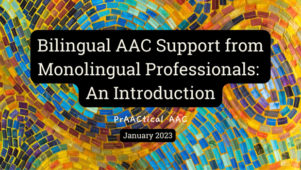
Welcome to the first post in a series by BilingüeAAC on supporting individuals with AAC needs in Spanish. In today’s post, they introduce us to the series focusing on ways that monolingual therapists can better support Spanish bilingual individuals who are AAC users. BilingüeAAC is a group of SLPs with a shared belief in providing evidence-based intervention strategies and resources to bilingual Spanish AAC clients, families, caregivers, and professionals. ::::::::::::::::::::::::::::::::::::::::::::::::::::::::::::: A Monolingual SLP’s Guide to Demystifying CLD Practices for Bilingual Spanish AAC Intervention If all languages hold unique systematic rules, can we translate English AAC core words to Spanish and begin modeling? What about morpho-syntax? What about inclusive practices? How can monolingual therapists provide culturally linguistically responsive intervention to their bilingual clients? BILINGUAL AAC USERS Currently, there is limited research on the number of Spanish-speaking AAC users and providers. However, according to the Demographic Profile of ASHA Members Providing Bilingual... [Read More...]
January 9, 2023
by Carole Zangari -
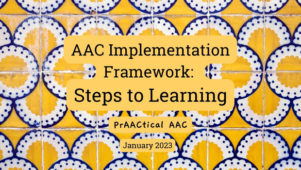
We’re so pleased to welcome PrAACtical AAC contributor Vicki Clarke back to these pages. While you may remember Vicki from her outstanding AAC Assessment Corner posts, her most recent efforts focus on strengthening our AAC practices. Throughout the series, Vicki draws on her experiences supporting AAC users and teams in clinical and school settings and shares prAACtical information that we can all learn from Introduction to AAC 101 Steps to Learning It is no small task to consider how we will help our students progress from communicating only through behaviors to communicating any message they desire independently and spontaneously. In fact, in 1997, Gloria Soto conducted survey research that tells us: Teachers have always believed that communication training for students is positive, and Communication training is a collaborative effort between teachers and SLPs, Despite these beliefs, there is still a prevalent hesitancy to begin to explicitly instruct students in AAC.... [Read More...]
January 5, 2023
by Carole Zangari -
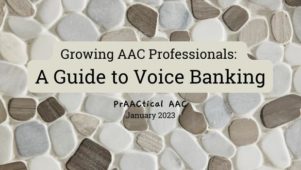
When university faculty and graduate students work together on AAC content, good things are bound to happen. In this post, we hear from Clinical Associate Professor and SLP Krista Davidson, a strong advocate for AAC, and Katie Gardner, a graduate student in the Communication Sciences and Disorders program at the University of Iowa. They collaborated on the development of a guide to voice banking and are now making it available to all. :::::::::::::::::::::::::::::::::::::::::::::::::::::::::::::::::::::::::::::::::::::::::::::::: I have a student project I’m thrilled to share with a larger audience! One of our second-year graduate students, Katie Gardner, created a thorough and detailed guide to voice and message banking. Although the developers of voice banking programs make every effort to design user-friendly software, the whole process can still be quite daunting to some clients and families. From the services to the devices, to the cost, setup, and recordings, there are many considerations that can... [Read More...]
January 2, 2023
by Carole Zangari -
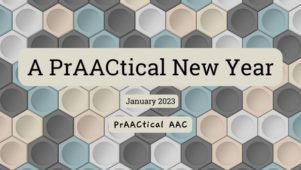
With 2022 in the rear-view mirror, we’re excited to welcome some prAACtical additions in the New Year. Here are a few things to watch for in the months to come. AAC Implementation Series PrAACtical AAC contributor Vicki Clarke will be back with a limited series on strengthening our AAC practices. Here’s what she shared about the direction of this series. The journey from acquiring an AAC system to using it to communicate autonomously is a long one, with many different routes. Knowing where to begin is a challenge for all of us! AAC 101 Steps of Learning Process is our effort to define this process in our schools, to help professionals and families support their students. In this series of posts, we are considering 5 steps, to move from training to talking, offering a defined path for you and your student learner. Learning to communicate is a shared journey between... [Read More...]
December 30, 2022
by praacticalaac -
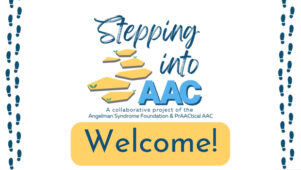
Stepping into AAC is a joint project between the Angelman Syndrome Foundation and PrAACtical AAC. You can access the project information and materials through either site. Access Stepping into AAC through the Angelman Syndrome Foundation site: Click here. Access Stepping into AAC on PrAACtical AAC: Click here. Stepping Into AAC Team Principal Investigator: Carole Zangari Video Manager and Signposts Creator: Tabi Jones Wohleber Graphics and AACtion Steps Creator: Rachael Langley Videography, Audio, and Editing: Michaela Ball Travelog Contributing Author: Krista Hadeed Larson Additional Videography: Zack Hoaglund
December 28, 2022
by Carole Zangari -
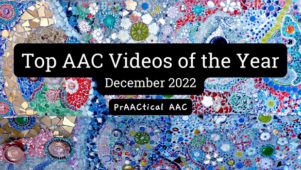
Videos are a great tool for building our AAC knowledge base and strengthening our implementation practices. Here are the ones that were most popular in 2022. Helping School Staff Model AAC in the Classroom Introduction to the Communication Matrix Resources AAC Modeling at Home AAC Apps for Visual Scene Displays Dealing with Emotions, AAC Style AAC with Eddie the Elephant Getting Familiar with Partner-Assisted Scanning TELL ME – AAC in the Preschool Classroom Getting Started with Eye Gaze SGDs Video Models & Visual Supports for AAC Look for more helpful videos on AAC and related topics in 2023. Happy New Year, everyone!
December 12, 2022
by Carole Zangari -
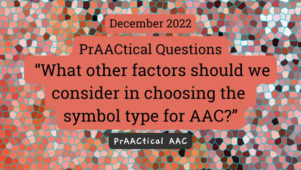
If you’ve been following along in our PrAACtical Questions series, you know that we’ve been contemplating the role that symbols play in AAC decision-making. Previously, we addressed: “How can we make data-based decisions about AAC symbols?” “How important is symbol selection in choosing AAC devices/apps?” and, “What symbols are used in AAC apps & SGDs?” If you’ve followed this series, you know that we’ve advocated an individualized approach to determining which type of symbol to use for AAC. Informal assessment tasks, such as the ones we discussed in a past post, can be helpful in gathering data to use in making this decision. Today, we’re exploring additional factors to consider in symbol selection. When there doesn’t seem to be a clear preference and/or when the performance is similar across symbol types, we turn to some other factors that are worth considering as you make your selection. AAC User Perspective A... [Read More...]
December 4, 2022
by Carole Zangari -
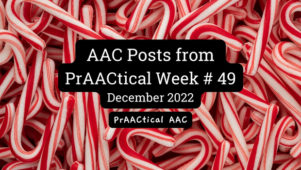
Happy Sunday, AAC friends. We have some AAC reading for you to catch up on. Monday – PrAACtical Questions: “How important is symbol selection in choosing AAC devices/apps?” Tuesday – AAC Link Up Wednesday – Video of the Week: Sending AAC Home Thursday – December Year of Core Vocabulary & School Year of Core Vocabulary Words Friday – PráctiCAAmente Conectados: CAA Con Links – Diciembre 2022 Many thanks to the team at Feedspot for honoring us with the top spot in their list of 20 Best AAC Blogs & Websites. Congratulations to all the organizations who were recognized. If AAC is your jam, check out the list for groups who publish regularly about AAC topics. Still have time for a little more AAC? Here are some of our suggestions. Personal Narrative Writing & AAC Helping Beginning Communicators Expand Their Sentence Length 5 Ways to Make Semantic Maps More Effective in... [Read More...]
November 24, 2022
by Carole Zangari -
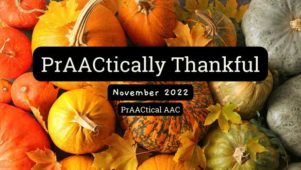
grat·i·tude /ˈɡradəˌt(y)o͞od/ noun the quality of being thankful; readiness to show appreciation for and to return kindness In the spirit of our American tradition of Thanksgiving, we pause to reflect on our blessings and offer thanks. We’re grateful for: The people who use AAC and their families for all they do to help us get better at this business of supporting communication Service providers in homes, schools, clinics, hospitals, and community agencies The university programs that have a dedicated AAC class, especially if they have a permanent faculty member with expertise in this area Bonus thanks to those that also offer supervised clinical or student teaching experiences with AAC mentorship opportunities or an AAC lab with SGDs, AAC apps, switches, and mounts. The professional and service organizations that support AAC through professional development opportunities, grants, mentorship programs The power of e-communication platforms for the AAC support on listservs, blogs, groups, threaded... [Read More...]
November 3, 2022
by Carole Zangari -
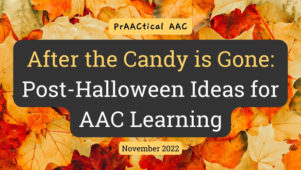
We’re sharing some ideas for AAC learning based on a previous post by the late Dr. Robin Parker. :::::::::::::::::::::::::::::::: Language learning involves talking about events in the past, present, and future. Since Halloween is over, it is a perfect opportunity to help AAC users talk about past events. Here are 5 tips for getting started. Use a weekly or monthly (calendar) schedule to ‘remember’ Halloween, or if you are sticking to core words to remember the “great day” or “bad day” depending upon the experience. Use photos of the Halloween festivities to discuss what happened and what everyone did. You can use these to discuss costumes, decorations, the best/worst part of the day, etc. Use a Venn diagram to compare and contrast Halloween experiences. This can be done by comparing two people, places, or anything else. For some learners, you can use images to put Halloween things that everyone saw... [Read More...]









